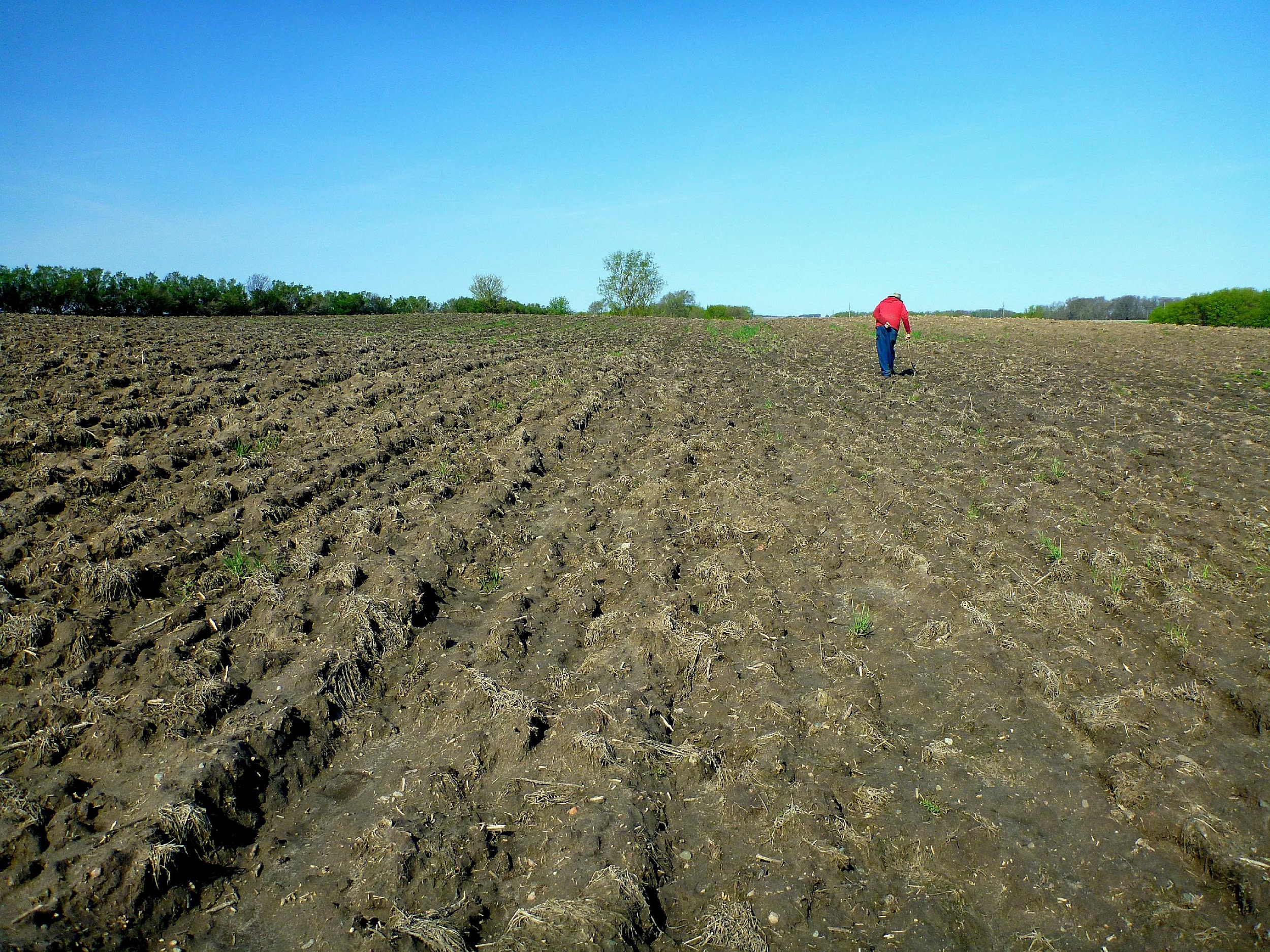Bob Suchanek, Waters and Wetlands Steward

Walking the Field. Photo Credit: Bob Suchanek
The land ethic simply enlarges the boundaries of the community to include soils, waters, plants, and animals; or collectively: the land. - Aldo Leopold
Farming is always about the land; it's not just making a living. Farming is a devotion to place, the health of that place and the sustainable productivity of that place.
Aldo Leopold's A Sand County Almanac and “The Land Ethic” opened my eyes to agriculture and environmental stewardship. Published posthumously in 1949, Leopold's most influential work was nearly two decades old by the time it was an assigned college reading for me. Leopold understood farming as an enterprise that involves thinking about both economics and ecology. He advised that we “quit thinking about decent land-use as solely an economic problem. Examine each question in terms of what is ethically and aesthetically right, as well as what is economically expedient”.
A thing is right when it tends to preserve the integrity, stability, and beauty of the biotic community. It is wrong when it tends otherwise.” - Aldo Leopold
Every two years the Minnesota Pollution Control Agency issues a list of water bodies that exceed surface water quality standards. In 2021 more than half of Minnesota's waters are considered “impaired”. Water quality issues ranged from high levels of mercury and agricultural chemicals to turbidity and biological contamination. Of course not all impairments are the result of farming practices, but they are all related to impairment of “the integrity, stability, and beauty” of the land.
My grandfather came to Minnesota in the 19th century, plowed with horses, and fertilized his fields with manure. In the 20th century my uncles plowed with tractors and fertilized their fields with industrially produced fertilizers. In the 21st century my cousin's tractors are bigger and fertilizers are just one of many chemical and biological options for enhancing crop production.
The coming age is to be seen as the age of stewardship: we are here not to govern and exploit, but to maintain and creatively transform.” - Henryk Skolimowski
I'm not a farmer. I spent some happy summers working on my uncle's farm many years ago and know a little about sweat and its benefits but ended up with a career elsewhere. I still love being outdoors and often think about my relationship to the land and, of course, what our collective relationship to the land should be. Many scientists are convinced that we've entered an extraordinary epoch; a period of time defined by the collective ability of humanity to influence climate and the environment. This human age or “Anthropocene” acknowledges our agency as a species. Going forward, what will the Anthropocene mean for the land?
In 2019, about ¼ of Minnesota's agricultural land was devoted to growing corn. Corn production is an excellent model for the evolution of agricultural technology and production, with recorded yields increasing from less than 2 tons per acre in 1940 to around 10 tons per acre in 2014. This happened through the widespread adoption of new corn varieties and the use of fertilizers, herbicides and synthetic pesticides.
There are millions of people organized around stewardship missions. For example, the Sierra Club and the Land Stewardship Project (LSP) share Aldo Leopold's holistic visions for integrating human activities with the greater living community. The mission of the Land Stewardship Project includes a mandate for “transformational change in our food and farming system” through inclusive and cooperative land stewardship by culturally and racially diverse rural and urban people”. The 3.8 million members of the Sierra Club seek to “practice and promote the responsible use of the Earth's ecosystems and resources” and “restore the quality of the natural and human environment” with a commitment to Equity and Environmental Justice.
This year the LSP (with the encouragement of the North Star Chapter of the Sierra Club) introduced a “100% Soil Healthy Farming” bill (HF 701) to the Minnesota Legislature. This bill was developed by a diverse team of LSP members (farmers and rural and urban residents) with long-term land stewardship goals in mind.
Amanda Koehler, organizer of the Soil Health and Climate Policy Campaign for the Land Stewardship Project framed the environmental roles farmers play, the practical constraints farmers face, and the nature of HF 701 as follows:
Farmers are uniquely positioned to both mitigate and build community resilience from the climate crisis, and are on the front lines of managing extreme weather events, emerging pests and disease, degrading topsoil, altered planting and harvesting timing, dwindling pollinator populations, and more. Thousands of farmers are weathering financial crises, industry consolidation, and insufficient processing, markets, and land access. Then there are the skyrocketing costs of rural healthcare, economic and health impacts of the pandemic, and the always increasing cost of living. When people are free from these barriers, creativity and innovation on the land flourish.
Our bill will:
Set a state-wide goal for 100 percent soil-healthy farming.
Launch new soil-healthy practices by providing farmers with accessible up-front grants that can be used on fencing for managed rotational grazing, seed, equipment, and other needs.
Sustain soil-healthy practices by providing farmers with up to five years of ongoing direct payments.
Prioritize grants and payments for black, brown and indigenous farmers, women farmers, and small and mid-sized farmers as a step toward racial, gender, and economic justice.
Track how soil health improves over time dependent on practices and geology.
Support the sharing and borrowing of equipment between neighbors and from Soil and Water Conservation Districts.
I think this legislation is a good start. Perhaps the Anthropocene will see the transformations and restoration that humanity must undertake for a sustainable future.
Sources:
https://landstewardshipproject.org
https://www.womenspress.com/work-with-farmers-to-build-climate-resistance/
https://www.revisor.mn.gov/bills/bill.php?b=house&f=HF701&ssn=0&y=2021